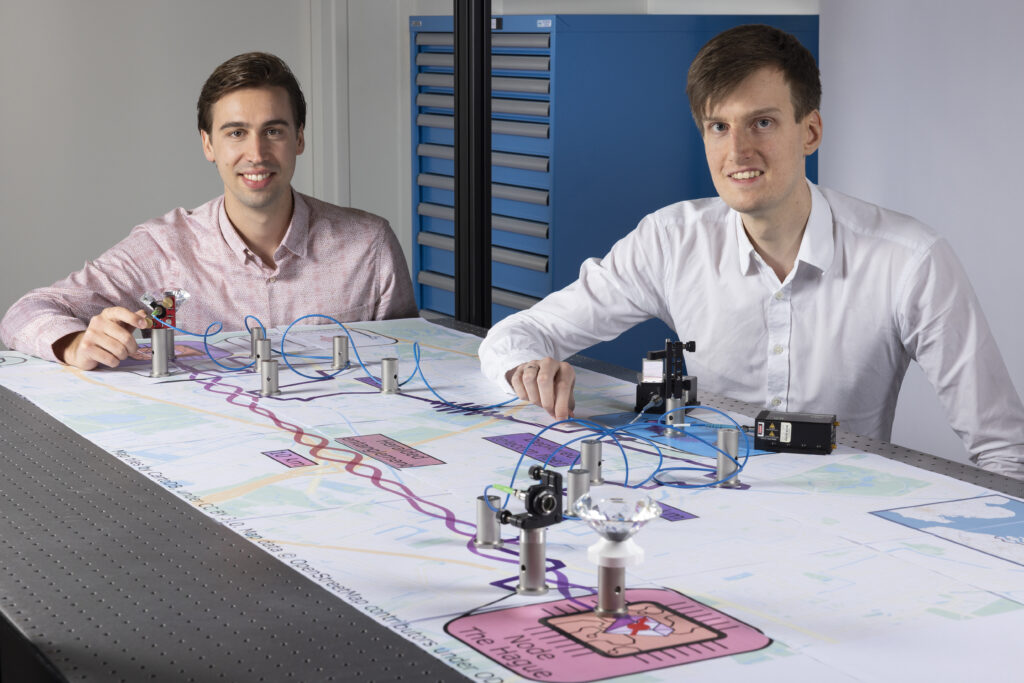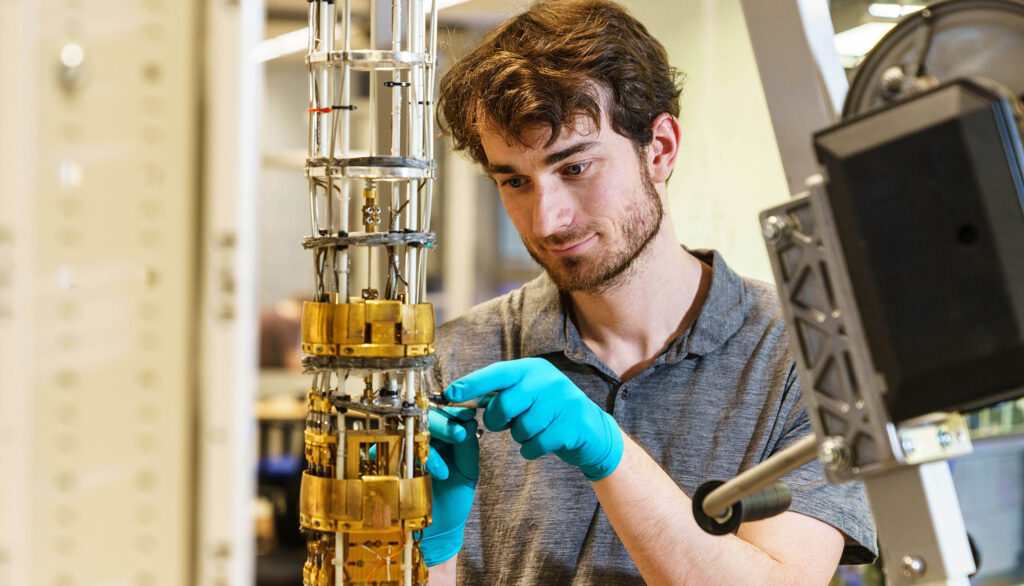30.10.2024Quantum Internet
A rudimentary quantum network link between Dutch cities

An international research team led by QuTech has demonstrated a network connection between quantum processors over metropolitan distances. Their result marks a key advance from early research networks in the lab towards a future quantum internet. The team developed fully independently operating nodes and integrated these with deployed optical internet fibre, enabling a 25 km quantum link. The researchers published their findings in Science Advances.
The internet allows people to share information (bits) globally. A future quantum internet will enable sharing quantum information (qubits) over a new type of network. Such qubits can not only take the values 0 or 1, but also superpositions of those (0 and 1 at the same time). In addition, qubits can be entangled, which means they share a quantum connection enabling instant correlations, no matter the distance.
Researchers around the globe are working to build quantum networks that make use of these features to offer fundamentally new communication and computing capabilities, in coexistence with the current internet. For example, qubits can generate secure encryption keys for safely sharing financial or medical data. Quantum links can also connect distant quantum computers, enhancing their power and allowing access with full privacy for users.
Moving out of the lab
An international team led by Ronald Hanson at QuTech—a collaboration between the TU Delft and TNO—was able to connect two small quantum computers between the Dutch cities of Delft and The Hague. “The distance over which we create quantum entanglement in this project, via 25 km of deployed underground fiber, is a record for quantum processors,” says Hanson. “This is the first time such quantum processors in different cities are connected.”
A few years ago the team reported the first multi-node quantum network inside the lab. “We were faced with new major challenges in going from these lab experiments to realizing a quantum link between cities. We had to design a flexible system that lets the nodes work independently over long distances, we needed to mitigate the impact of photon loss on the connection speed, and we had to ensure reliable confirmation each time the entanglement link was successfully created. Without these innovations, such a large distance would not have been possible.”
‘Like keeping the moon at a constant distance’
To tackle the challenge of photon loss, the team established the quantum connection using a photon-efficient protocol that required very precise stabilization of the connecting fiber link. Co-author Arian Stolk explains using an analogue: “The link needed to be stable well within the wavelength of the photons (smaller than a micrometer) over 25 kilometer of optical fiber. That challenge compares to keeping the distance between the earth and the moon constant with the accuracy of only a few millimeter. Through a combination of research insights and applied engineering, we were able to solve this puzzle.”
“In this work, we demonstrate successful entanglement between two quantum network nodes containing diamond spin qubits. The independently operated nodes are connected through a midpoint station via optical fiber. We were able to reliably deliver a pre-specified entangled state between the nodes.”

Kian van der Enden and Arian Stolk. Photo credit: Studio Oostrum for QuTech.
Collaboration between academia and industry
Co-author Kian van der Enden explains how indispensable the broad expertise of the team was for the success of the project: “Fraunhofer ILT developed a critical component for this demonstration, a new type of quantum frequency converter. OPNT delivered state-of-the-art timing hardware, Element6 provided high-quality qubit chip substrates and Toptica developed high-stability lasers. Finally, Dutch telecom provider KPN provided the fiber infrastructure as well as the locations of the nodes, the midpoint, and the node in The Hague.”
Solid foundation for European quantum internet
This result is an important milestone that addresses key scaling challenges for future quantum networks. Jesse Robbers, Director Industry & Digital Infrastructure of Quantum Delta NL that co-funded the research, adds: “We continue to show leadership in the development of the future fundament of our Digital Infrastructure and how to make it applicable, which is the core of the national and European strategy.”
The architecture and methods are directly applicable to other qubit platforms, including the next-generation scalable qubits that the team is currently developing. The successful use of deployed, conventional internet infrastructure sets the stage for a new phase on the road towards a quantum internet. Hanson: “This work marks the crucial step out of the research lab into the field, enabling exploration of first quantum processor networks at metropolitan scale.”
Publication details
Stolk & Van der Enden, et al. (2024) ‘Metropolitan-scale heralded entanglement of solid-state qubits’, Science Advances, DOI: 10.1126/sciadv.adp6442
In the media
- ‘Quantum internet’ demonstration in cities is most advanced yet – Nature News
- In de Randstad ligt nu het fundament voor een quantuminternet: ‘De meest geavanceerde demonstraties tot nog toe’ – De Volkskrant
- Onderweg naar het internet van de toekomst – tussen Delft en Den Haag is het vorig jaar al getest – NRC
- TNO en TU Delft maken quantumnetwerk van 25km tussen Den Haag en Delft – Tweakers.net
- Delft en Den Haag voorzien van quantumverbinding – De Ingenieur
- 25 km quantum network link between Dutch cities represents a key advance – Phys.org
- Bridging Cities with Quantum Links in Pursuit of the Quantum Internet – The Quantum Insider
- A rudimentary quantum network link between Dutch cities – Hacker News

